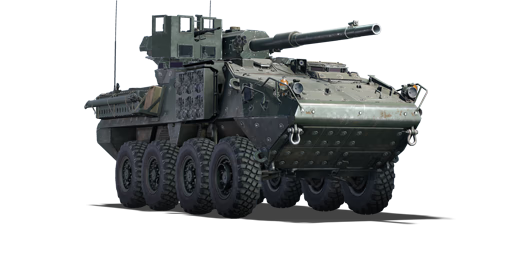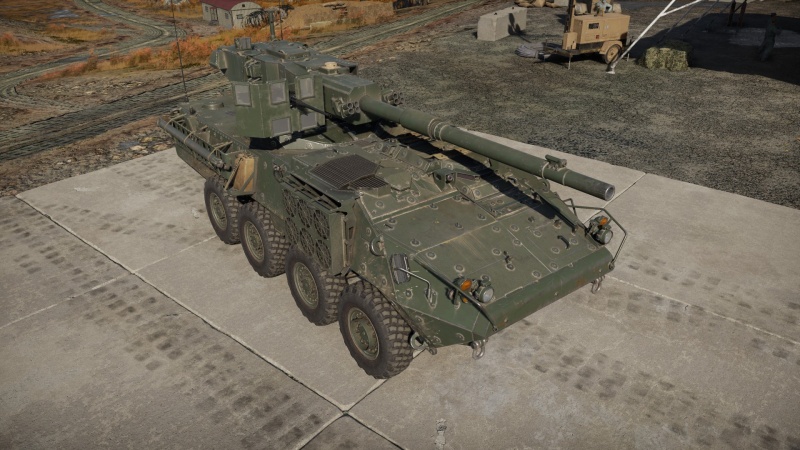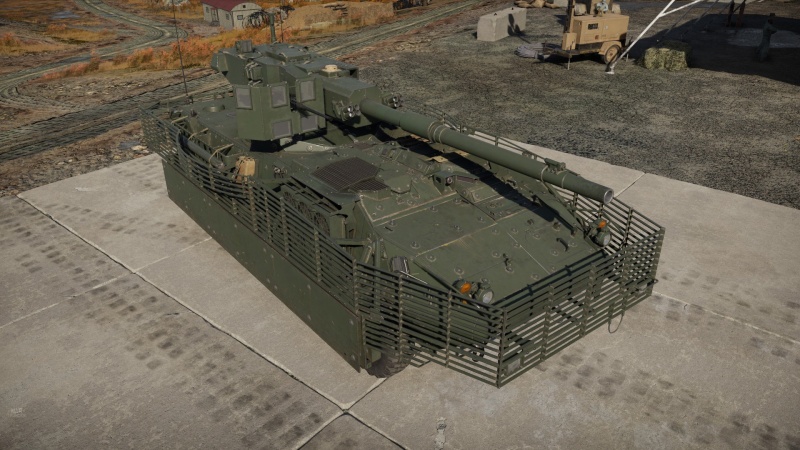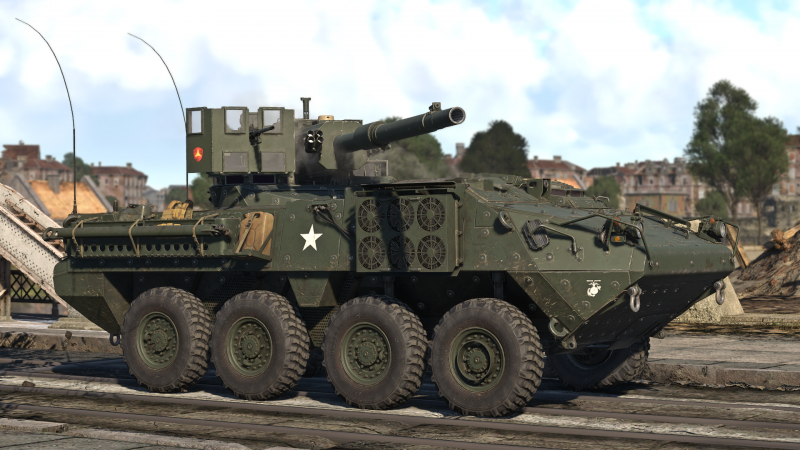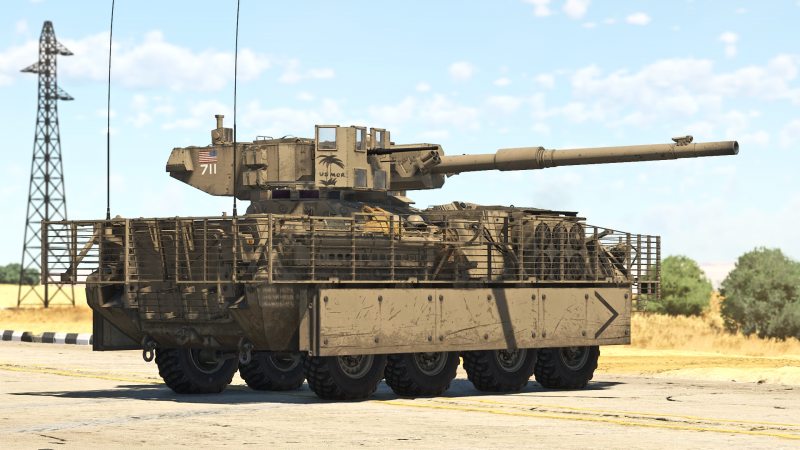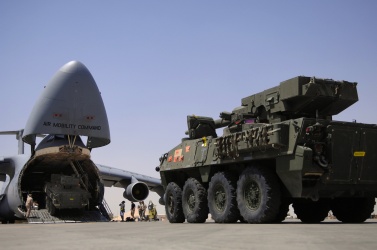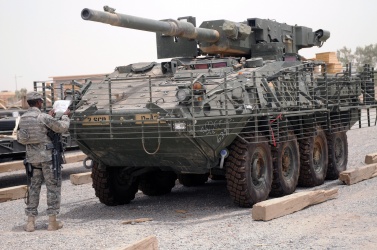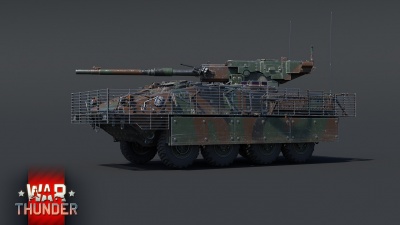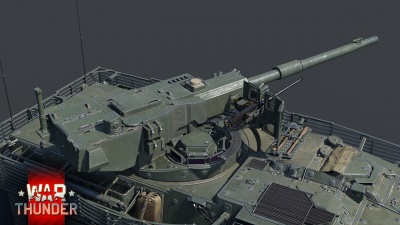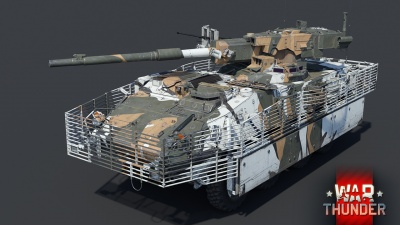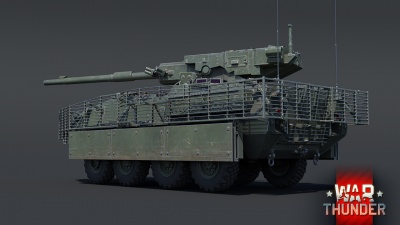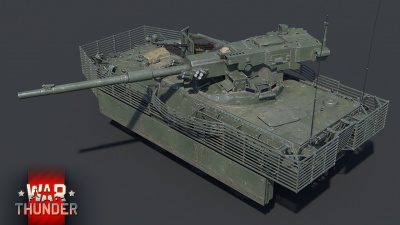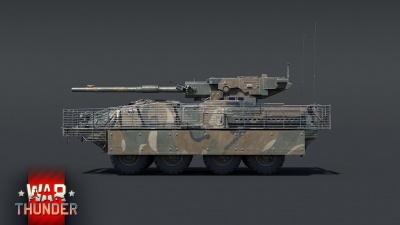Difference between revisions of "M1128"
(→Pros and cons) (Tag: Visual edit) |
Matsuri4life (talk | contribs) m (→Main armament: Autoloader) (Tag: Visual edit) |
||
| (46 intermediate revisions by 16 users not shown) | |||
| Line 1: | Line 1: | ||
| + | {{About | ||
| + | | about = American light tank '''{{PAGENAME}}''' | ||
| + | | usage = the premium version | ||
| + | | link = M1128 Wolfpack | ||
| + | }} | ||
{{Specs-Card | {{Specs-Card | ||
|code=us_m1128_mgs | |code=us_m1128_mgs | ||
| − | |images={{Specs-Card-Image|GarageImage_{{PAGENAME}}.jpg}} | + | |images={{Specs-Card-Image|GarageImage_{{PAGENAME}}.jpg|GarageImage_{{PAGENAME}}_AddArmour.jpg|ArtImage_{{PAGENAME}}.png|ArtImage2_{{PAGENAME}}.png}} |
}} | }} | ||
== Description == | == Description == | ||
<!-- ''In the description, the first part should be about the history of the creation and combat usage of the vehicle, as well as its key features. In the second part, tell the reader about the ground vehicle in the game. Insert a screenshot of the vehicle, so that if the novice player does not remember the vehicle by name, he will immediately understand what kind of vehicle the article is talking about.'' --> | <!-- ''In the description, the first part should be about the history of the creation and combat usage of the vehicle, as well as its key features. In the second part, tell the reader about the ground vehicle in the game. Insert a screenshot of the vehicle, so that if the novice player does not remember the vehicle by name, he will immediately understand what kind of vehicle the article is talking about.'' --> | ||
| − | The '''{{Specs|name}}''' is a rank {{Specs|rank}} American tank | + | The '''{{Specs|name}}''' is a rank {{Specs|rank}} American light tank {{Battle-rating}}. It was introduced in [[Update "New Power"]]. |
== General info == | == General info == | ||
| Line 15: | Line 20: | ||
'''Armour type:''' | '''Armour type:''' | ||
| − | * High | + | * High-hardness rolled armour - Hull and turret |
| − | * MEXAS 2C - Applique | + | * MEXAS 2C - Applique armour on hull and lower turret |
{| class="wikitable" | {| class="wikitable" | ||
| Line 45: | Line 50: | ||
'''Notes:''' | '''Notes:''' | ||
| − | * .50 cal machine gun shield has 12.7 mm of | + | * .50 cal machine gun shield has 12.7 mm of armour protection. |
* Wheels provide 10 mm of protection. | * Wheels provide 10 mm of protection. | ||
| − | |||
| − | ==== Additional | + | ==== Additional Armour ==== |
{| class="wikitable" | {| class="wikitable" | ||
!Armour | !Armour | ||
!Location | !Location | ||
|- | |- | ||
| − | |Spaced | + | |Spaced Armour |
|Between engine compartment and the crew compartment | |Between engine compartment and the crew compartment | ||
Between hull front and driver | Between hull front and driver | ||
|- | |- | ||
| − | |Slat | + | |Slat Armour |
|All four sides of the hull | |All four sides of the hull | ||
|- | |- | ||
| Line 65: | Line 69: | ||
|}'''Notes:''' | |}'''Notes:''' | ||
| − | * Sideskirts: 6.35 mm High Hardness Rolled | + | * Sideskirts: 6.35 mm High Hardness Rolled Armour + 6.35 mm High Hardness Rolled Armour + 50 mm Composite Screen |
| − | * Spaced | + | * Spaced Armour: 5 mm Rolled Homogeneous Armour |
| − | * Slat | + | * Slat Armour: 10 mm |
| − | |||
=== Mobility === | === Mobility === | ||
{{Specs-Tank-Mobility}} | {{Specs-Tank-Mobility}} | ||
| − | <!-- ''Write about the mobility of the ground vehicle. Estimate the specific power and manoeuvrability, as well as the maximum speed forwards and backwards.'' -->{{tankMobility|abMinHp= | + | <!-- ''Write about the mobility of the ground vehicle. Estimate the specific power and manoeuvrability, as well as the maximum speed forwards and backwards.'' --> |
| + | |||
| + | {{tankMobility|abMinHp=542|rbMinHp=310|AoAweight=4.7|weight=23.4}} | ||
=== Modifications and economy === | === Modifications and economy === | ||
| Line 83: | Line 88: | ||
<!-- ''Give the reader information about the characteristics of the main gun. Assess its effectiveness in a battle based on the reloading speed, ballistics and the power of shells. Do not forget about the flexibility of the fire, that is how quickly the cannon can be aimed at the target, open fire on it and aim at another enemy. Add a link to the main article on the gun: <code><nowiki>{{main|Name of the weapon}}</nowiki></code>. Describe in general terms the ammunition available for the main gun. Give advice on how to use them and how to fill the ammunition storage.'' --> | <!-- ''Give the reader information about the characteristics of the main gun. Assess its effectiveness in a battle based on the reloading speed, ballistics and the power of shells. Do not forget about the flexibility of the fire, that is how quickly the cannon can be aimed at the target, open fire on it and aim at another enemy. Add a link to the main article on the gun: <code><nowiki>{{main|Name of the weapon}}</nowiki></code>. Describe in general terms the ammunition available for the main gun. Give advice on how to use them and how to fill the ammunition storage.'' --> | ||
{{main|M68A1E8 (105 mm)}} | {{main|M68A1E8 (105 mm)}} | ||
| − | |||
{| class="wikitable" style="text-align:center" width="100%" | {| class="wikitable" style="text-align:center" width="100%" | ||
|- | |- | ||
| − | ! colspan="5" | [[M68A1E8 (105 mm)|105 mm M68A1E8]] || colspan="5" | Turret rotation speed (°/s) | | + | ! colspan="5" | [[M68A1E8 (105 mm)|105 mm M68A1E8]] || colspan="5" | Turret rotation speed (°/s) || Reloading rate (seconds) |
|- | |- | ||
! Mode !! Capacity !! Vertical !! Horizontal !! Stabilizer | ! Mode !! Capacity !! Vertical !! Horizontal !! Stabilizer | ||
! Stock !! Upgraded !! Full !! Expert !! Aced | ! Stock !! Upgraded !! Full !! Expert !! Aced | ||
| − | ! | + | !Autoloader |
|- | |- | ||
! ''Arcade'' | ! ''Arcade'' | ||
| − | | rowspan="2" | 18 || rowspan="2" | -5°/+15° || rowspan="2" | ±180° || rowspan="2" | Two-plane || | + | | rowspan="2" | 18 || rowspan="2" | -5°/+15° || rowspan="2" | ±180° || rowspan="2" | Two-plane || 38.1 || 52.7 || 64.0 || 70.7 || 75.3 || rowspan="2" | 7.50 |
|- | |- | ||
! ''Realistic'' | ! ''Realistic'' | ||
| − | | | + | | 23.8 || 28.0 || 34.0 || 37.6 || 40.0 |
|- | |- | ||
|} | |} | ||
==== Ammunition ==== | ==== Ammunition ==== | ||
| − | { | + | {{:M68A1E8 (105 mm)/Ammunition|M456A2, M774, M900}} |
| − | |||
| − | |||
| − | |||
| − | |||
| − | |||
| − | | | ||
| − | |||
| − | |||
| − | |||
| − | |||
| − | |||
| − | |||
| − | |||
| − | |||
| − | |||
| − | |||
| − | |||
| − | |||
| − | |||
| − | |||
| − | |||
| − | |||
| − | |||
| − | |||
| − | |||
| − | |||
| − | |||
| − | |||
| − | |||
| − | |||
| − | |||
| − | |||
| − | |||
| − | |||
| − | |||
| − | |||
| − | |||
| − | |||
| − | |||
| − | |||
| − | |||
| − | |||
| − | |||
| − | |||
| − | |||
==== [[Ammo racks]] ==== | ==== [[Ammo racks]] ==== | ||
[[File:Ammoracks_{{PAGENAME}}.jpg|right|thumb|x250px|[[Ammo racks]] of the {{PAGENAME}}]] | [[File:Ammoracks_{{PAGENAME}}.jpg|right|thumb|x250px|[[Ammo racks]] of the {{PAGENAME}}]] | ||
| − | <!-- '''Last updated: 2. | + | <!-- '''Last updated: 2.27.2.27''' --> |
{| class="wikitable" style="text-align:center" | {| class="wikitable" style="text-align:center" | ||
|- | |- | ||
| Line 162: | Line 121: | ||
|- | |- | ||
|} | |} | ||
| + | '''Notes''': | ||
| + | |||
| + | * Shells are modeled individually and disappear after having been shot or loaded. | ||
| + | * Rack 2 (autoloader magazine) is a first stage ammo rack and totals 8 shells. | ||
| + | * As the {{PAGENAME}} is equipped with an autoloader, manual reloading of the gun is not possible. | ||
| + | * Once the autoloader magazine has been depleted, you can't shoot until the loader has restocked the autoloader with at least one shell. | ||
| + | * The restocking time is longer than the normal reload time of the gun. Take this into account when playing. | ||
| + | * Simply not firing when the gun is loaded will move ammo from rack 1 into rack 2. Firing will interrupt the restocking of the ready racks. | ||
=== Machine guns === | === Machine guns === | ||
| Line 168: | Line 135: | ||
<!-- ''Offensive and anti-aircraft machine guns not only allow you to fight some aircraft but also are effective against lightly armoured vehicles. Evaluate machine guns and give recommendations on its use.'' --> | <!-- ''Offensive and anti-aircraft machine guns not only allow you to fight some aircraft but also are effective against lightly armoured vehicles. Evaluate machine guns and give recommendations on its use.'' --> | ||
{{main|M2HB (12.7 mm)|M240 (7.62 mm)}} | {{main|M2HB (12.7 mm)|M240 (7.62 mm)}} | ||
| + | |||
{| class="wikitable" style="text-align:center" width="50%" | {| class="wikitable" style="text-align:center" width="50%" | ||
|- | |- | ||
| Line 174: | Line 142: | ||
! Mount !! Capacity (Belt) !! Fire rate !! Vertical !! Horizontal | ! Mount !! Capacity (Belt) !! Fire rate !! Vertical !! Horizontal | ||
|- | |- | ||
| − | |Pintle|| 400 (200) ||577|| -5° / +30° || -5° / +70° | + | | Pintle || 400 (200) || 577 || -5°/+30° || -5°/+70° |
|- | |- | ||
|} | |} | ||
| Line 183: | Line 151: | ||
! Mount !! Capacity (Belt) !! Fire rate !! Vertical !! Horizontal | ! Mount !! Capacity (Belt) !! Fire rate !! Vertical !! Horizontal | ||
|- | |- | ||
| − | |Coaxial|| | + | | Coaxial || 3,400 (200) || 941 || N/A || N/A |
|- | |- | ||
|} | |} | ||
| Line 189: | Line 157: | ||
== Usage in battles == | == Usage in battles == | ||
<!-- ''Describe the tactics of playing in the vehicle, the features of using vehicles in the team and advice on tactics. Refrain from creating a "guide" - do not impose a single point of view but instead give the reader food for thought. Describe the most dangerous enemies and give recommendations on fighting them. If necessary, note the specifics of the game in different modes (AB, RB, SB).'' --> | <!-- ''Describe the tactics of playing in the vehicle, the features of using vehicles in the team and advice on tactics. Refrain from creating a "guide" - do not impose a single point of view but instead give the reader food for thought. Describe the most dangerous enemies and give recommendations on fighting them. If necessary, note the specifics of the game in different modes (AB, RB, SB).'' --> | ||
| − | + | The M1128 is best played as an ambush-sniper. Take full advantage of the vehicle's mobility to get to sniping positions first and avoid open areas when you can. With the M1128's unmanned turret, it is best used at a hull-down position. The M1128 is also vulnerable to the overpressure mechanic and has inconsistent and poor armour which means that you should approach all enemies with caution. When the opportunity presents itself, it is always best to double back or reposition and fight your enemy in a position fight. | |
| + | |||
| + | '''Urban combat''' | ||
| + | |||
| + | The M1128 performs rather poorly in urban combat since it is a large vehicle. Although it has an excellent turret traverse speed, close-quarters fighting is not advised as the tank is vulnerable to all kinds of fire. The M1128's reload rate is decent for its BR and is able to quickly dispatch multiple enemies. Therefore, you should avoid close-quarters engagements and try to reposition when possible. | ||
| + | |||
| + | '''Rural Combat''' | ||
| + | |||
| + | The M1128 excels in large, open maps. Taking full advantage of its mobility and firepower, it is best to reach advantageous positions early in the game. Using the high-resolution thermal sights, it is easy to spot enemies and quickly neutralize them. | ||
=== Pros and cons === | === Pros and cons === | ||
| Line 196: | Line 172: | ||
'''Pros:''' | '''Pros:''' | ||
| − | * High resolution thermal gunner and commander optics, as well as low resolution driver thermal optics. | + | * High resolution thermal gunner and commander optics (3rd generation), as well as low resolution driver thermal optics (1st generation). |
* Has access to the M900 high penetration APFSDS round when spaded. | * Has access to the M900 high penetration APFSDS round when spaded. | ||
| − | * Autoloader allows a | + | * Autoloader allows a 7.5 second reload no matter the amount of crew members left or their health. |
* Can put another shell in the autoloader in only 6 seconds; it is not affected by crew skill. | * Can put another shell in the autoloader in only 6 seconds; it is not affected by crew skill. | ||
| − | * High turret traverse speed ( | + | * High turret traverse speed (40°/sec with an ace crew) allows great reactionary ability. |
* Unmanned turret can protect the crew from harm thanks to their location in the hull. | * Unmanned turret can protect the crew from harm thanks to their location in the hull. | ||
* Can fire smoke grenades three times, four grenades each time (total of 12 smoke grenades). | * Can fire smoke grenades three times, four grenades each time (total of 12 smoke grenades). | ||
| − | * .50 | + | * .50 calibre machine gun can be used against low-flying aerial targets and lightly armoured ground vehicles. |
| − | * | + | * Acceleration is good especially without the add-on slat armour |
| − | |||
'''Cons:''' | '''Cons:''' | ||
| − | * 7 second reload is longer than for many vehicles with a 105 mm gun and | + | * 7.5 second reload is longer than for many vehicles with a 105 mm gun and an expert or ace crew. |
| + | * .50 calibre machine gun does not have full 360 degrees of traverse unlike most other pintle-mounted guns | ||
* Can only carry 18 rounds of ammunition, which may not always be enough. | * Can only carry 18 rounds of ammunition, which may not always be enough. | ||
| − | * Thin | + | * Thin armour can only protect against machine gun rounds; it is not able to protect against autocannons. |
* It has a very large profile, making it an easy target. | * It has a very large profile, making it an easy target. | ||
| − | * Suffers mildly from | + | * Suffers mildly from overpressure mechanic. |
| − | |||
* Can not neutral steer and the off-road mobility is poor because of the wheeled design. | * Can not neutral steer and the off-road mobility is poor because of the wheeled design. | ||
| − | * | + | * Add-on slat armour around the vehicle is quite inconsistent with stopping HEAT/HEAT-FS shells. |
| + | ** Slat armour also adds 5 tons of weight, reducing the power-to-weight ratio to 14.96 hp/ton; severely impacts acceleration | ||
| + | * Poor gun depression angles | ||
== History == | == History == | ||
| Line 222: | Line 199: | ||
=== Development === | === Development === | ||
| − | The XM1128 MGS was designed by General Dynamics Land Systems (GDLS) - Canada to meet the US | + | [[File:M1128Stryker Loading Lockheed C-5 Galaxy.jpg|x250px|left|none|thumb|Two M1128 Strykers being loaded into C-5 Galaxy aircraft, representing its ability to be transportable by air.]] |
| + | The XM1128 MGS was designed by General Dynamics Land Systems (GDLS) - Canada to meet the US Army's Mobile Gun System (MGS) requirement, a requirement for an airmobile infantry support platform that could double in the anti-tank role. The first XM1128 prototype was completed in 1999, and after being chosen as the winner of the competition, eight pre-production units began delivery in 2002 after being redesignated as the M1128 Stryker MGS. The M1128 Stryker entered service with the US Army in 2007. | ||
| − | The M1128 Stryker uses the chassis of the GDLS-Canada Stryker - which is based on the LAV-III. | + | The M1128 Stryker uses the chassis of the GDLS-Canada Stryker - which is based on the LAV-III. The General Dynamics Low-Profile Turret (LPT) is used, which is a modified version of the turret from the Expeditionary Tank. It is designed to be light enough to easily be transported by air. In 2005, after issues with the autoloading mechanism, the autoloader was changed. |
| − | === | + | === Design === |
The driver sits in the front left part of the hull, next to the engine on the right side. The driver can access his position through a hinged, one piece folding hatch or through the crew compartment. Three M17 day periscopes are located in the driver's hatch; the first one can be replaced by an image intensifier for night operations. A thermal viewer can be fitted in front of the driver as well. | The driver sits in the front left part of the hull, next to the engine on the right side. The driver can access his position through a hinged, one piece folding hatch or through the crew compartment. Three M17 day periscopes are located in the driver's hatch; the first one can be replaced by an image intensifier for night operations. A thermal viewer can be fitted in front of the driver as well. | ||
The LPT is located towards the rear of the hull, with the commander sitting on the right and the gunner on the left, rounding off the crew of three. The LPT is significantly lighter than a conventional turret, whilst also presenting a smaller target to the enemy. | The LPT is located towards the rear of the hull, with the commander sitting on the right and the gunner on the left, rounding off the crew of three. The LPT is significantly lighter than a conventional turret, whilst also presenting a smaller target to the enemy. | ||
| − | The main armament is a 105 mm | + | The main armament is a 105 mm M68A1E8 gun. It has 360° of traverse and elevation angles of -5° to +15°. The turret uses electrical controls, but manual controls are available for emergency situations. Both the gunner and commander can control the turret and fire the main gun. The main gun has a fire rate of 10 rounds per minute. |
The main gun is fed by an automatic loading system, replacing a human loader. The automatic loading system contains eight rounds, and ten more rounds are carried in the hull for a total of 18 rounds of 105 mm ammunition. The autoloading mechanism can be refilled automatically with only six seconds per shell. | The main gun is fed by an automatic loading system, replacing a human loader. The automatic loading system contains eight rounds, and ten more rounds are carried in the hull for a total of 18 rounds of 105 mm ammunition. The autoloading mechanism can be refilled automatically with only six seconds per shell. | ||
| Line 243: | Line 221: | ||
The main gun and coaxial machine gun are fully stabilized, as are the gunner and commander's sights. The General Dynamics fire-control computer is used as the fire-control system (FCS). | The main gun and coaxial machine gun are fully stabilized, as are the gunner and commander's sights. The General Dynamics fire-control computer is used as the fire-control system (FCS). | ||
| − | The M1128 utilizes welded steel | + | The M1128 utilizes welded steel armour, with a layer of ceramic applique armour bolted to the exterior as standard. A small liner is fitted to specific areas of the interior to minimize the damage of a penetration. |
| − | An | + | An armour package consisting of slat, also known as bar, armour can be fitted. This prematurely detonated rocket propelled grenades, preventing penetration. To further enhance protection, composite screens can be added to protect the wheels. |
| − | The powerpack is located in the front of the hull, to the right of the driver. It consists of a Caterpillar 3126A diesel engine - producing 350 horsepower - and an Allison MD 3560 P automatic transmission. The transmission has six forward gears and one reverse gear. The maximum attainable speed is 100 | + | The powerpack is located in the front of the hull, to the right of the driver. It consists of a Caterpillar 3126A diesel engine - producing 350 horsepower - and an Allison MD 3560 P automatic transmission. The transmission has six forward gears and one reverse gear. The maximum attainable speed is 100 km/h, and it has a range of 530 km. |
The M1128 has eight wheels and uses power-assisted steering, with the front two axles being engaged in steering. A central tire pressure regulation system is fitted to allow the adjustment of tire pressure as needed. | The M1128 has eight wheels and uses power-assisted steering, with the front two axles being engaged in steering. A central tire pressure regulation system is fitted to allow the adjustment of tire pressure as needed. | ||
| Line 254: | Line 232: | ||
An auxiliary power unit (APU) can be fitted, as can a hydraulic winch for self-recovery or for moving of other vehicles or obstacles. | An auxiliary power unit (APU) can be fitted, as can a hydraulic winch for self-recovery or for moving of other vehicles or obstacles. | ||
| + | [[File:Stryker Afghanistan - DVIDSHUB 100531-A-------004.jpg|x250px|right|none|thumb|A M1128 Stryker in Afghanistan fitted with slat armour.]] | ||
| − | === | + | === Production and Service === |
The XM1128 prototype was first built in 1999, and eight pre-production vehicles were built by 2002. The Army originally planned to purchase 204 M1128 Strykers, but only ended up buying 142 in total, due to issues with the turret and autoloader. | The XM1128 prototype was first built in 1999, and eight pre-production vehicles were built by 2002. The Army originally planned to purchase 204 M1128 Strykers, but only ended up buying 142 in total, due to issues with the turret and autoloader. | ||
In 2013, there were 27 M1128 Strykers assigned to each Stryker Brigade, but the number was then reduced to ten. The M1128 Stryker MGS is - and was always intended to be - used to support the infantry. Despite having anti-tank capability, anti-tank operations are a secondary role for the Stryker MGS, with infantry support being the primary role. | In 2013, there were 27 M1128 Strykers assigned to each Stryker Brigade, but the number was then reduced to ten. The M1128 Stryker MGS is - and was always intended to be - used to support the infantry. Despite having anti-tank capability, anti-tank operations are a secondary role for the Stryker MGS, with infantry support being the primary role. | ||
| − | + | A platoon of three Stryker MGS is attached to each Stryker infantry company, one MGS supporting each Stryker infantry platoon. | |
| + | |||
| + | Three M1128 Strykers have been lost to combat in the Middle East. | ||
| − | + | In 2022, the US Army announced the retirement of the original model of the M1128 Stryker MGS, citing obsolescence of its cannon and autoloader, as well as lack of protection against IEDs and anti-tank mines. Updated and improved variants of the Stryker continue to be operated in its absence. | |
=== [[wt:en/news/6934-development-m1128-stryker-mgs-en|Devblog]] === | === [[wt:en/news/6934-development-m1128-stryker-mgs-en|Devblog]] === | ||
| − | Following the end of the Cold War, leading U.S. Army theorists believed that the | + | Following the end of the Cold War, leading U.S. Army theorists believed that the armoured branch of the armed forces was no longer suitably equipped to perform future operations, projected to be "low-intensity" operations. As a result, the need for a new vehicle, which would bridge the gap between heavily and lightly armoured units, became increasingly apparent. |
| − | To address this, the Army issued a set of requirements for the new vehicle and invited close to a dozen manufacturers to design demonstrator vehicles to be tested in late 1999. Among them, General Dynamics Land | + | To address this, the Army issued a set of requirements for the new vehicle and invited close to a dozen manufacturers to design demonstrator vehicles to be tested in late 1999. Among them, General Dynamics Land Systems' LAV III-105 was eventually proclaimed the winner of the competition in November 2000. Shortly after, the LAV III-105 received the name 'Stryker' and plans were made to manufacture over 2,100 units. |
In 2002, the XM-M1128 MGS was built, however technical difficulties and deficiencies in the design caused delays to the start of its production. By 2005, low rate production of the vehicle was approved, while new shortcomings in the design were found. Eventually, the vehicle received a significant redesign of certain elements in 2008, being later approved for full production in 2014. | In 2002, the XM-M1128 MGS was built, however technical difficulties and deficiencies in the design caused delays to the start of its production. By 2005, low rate production of the vehicle was approved, while new shortcomings in the design were found. Eventually, the vehicle received a significant redesign of certain elements in 2008, being later approved for full production in 2014. | ||
| − | During its early production phase, several Stryker MGS vehicles were sent overseas for combat trials in the Middle East of which 3 would be lost. At present, over 140 M1128 Stryker | + | During its early production phase, several Stryker MGS vehicles were sent overseas for combat trials in the Middle East of which 3 would be lost. At present, over 140 M1128 Stryker MGS' have been built and actively serve with the U.S. Army. |
== Media == | == Media == | ||
| − | <!-- ''Excellent additions to the article would be video guides, screenshots from the game, and photos.'' --><gallery mode="packed" caption="M1128 Stryker MGS Devblog Images" heights="150"> | + | <!-- ''Excellent additions to the article would be video guides, screenshots from the game, and photos.'' --> |
| + | |||
| + | ;Skins | ||
| + | |||
| + | * [https://live.warthunder.com/feed/camouflages/?vehicle=us_m1128_mgs Skins and camouflages for the {{PAGENAME}} from live.warthunder.com.] | ||
| + | |||
| + | ;Images | ||
| + | <gallery mode="packed" caption="M1128 Stryker MGS Devblog Images" heights="150"> | ||
File:M1128 Stryker MGS WTWallpaper 001.jpg| | File:M1128 Stryker MGS WTWallpaper 001.jpg| | ||
File:M1128 Stryker MGS WTWallpaper 002.jpg| | File:M1128 Stryker MGS WTWallpaper 002.jpg| | ||
| Line 283: | Line 271: | ||
File:M1128 Stryker MGS WTWallpaper 007.jpg| | File:M1128 Stryker MGS WTWallpaper 007.jpg| | ||
</gallery> | </gallery> | ||
| + | |||
| + | ;Videos | ||
| + | {{Youtube-gallery|NlHdl2JAjfU|'''The Shooting Range #385''' - ''Pages of History'' section at 03:30 discusses the {{PAGENAME}}.|y2Ph0rmD5sU|'''Unmanned Turret Tanks: Showcasing New Tech''' discusses the {{PAGENAME}} at 03:47 - ''War Thunder Official Channel''|chjZ6Hra--c|'''Best wheeled tanks''' discusses the {{PAGENAME}} at 02:37 - ''War Thunder Official Channel''}} | ||
== See also == | == See also == | ||
| Line 288: | Line 279: | ||
* ''reference to the series of the vehicles;'' | * ''reference to the series of the vehicles;'' | ||
* ''links to approximate analogues of other nations and research trees.'' --> | * ''links to approximate analogues of other nations and research trees.'' --> | ||
| − | |||
| − | + | ;Other {{Annotation|MCV|Maneuver Combat Vehicle}}/{{Annotation|MGS|Mobile Gun System}}'s: | |
| − | * | + | |
| + | * [[File:South Africa_flag.png|20px|link=]] [[Rooikat (Family)]] | ||
| + | * [[File:Italy_flag.png|20px|link=]] [[Centauro (Family)]] | ||
| + | * [[File:FRG_flag.png|20px|link=]] [[Radkampfwagen 90]] | ||
| + | * [[File:Japan_flag.png|20px|link=]] [[Type 16]] | ||
| + | * [[File:France_flag.png|20px|link=]] [[AMX-10RC]] | ||
| + | * [[File:China_flag.png|20px|link=]] [[ZLT11]] | ||
== External links == | == External links == | ||
| Line 300: | Line 296: | ||
* [[wt:en/news/6934-development-m1128-stryker-mgs-en|[Devblog] M1128 Stryker MGS]] | * [[wt:en/news/6934-development-m1128-stryker-mgs-en|[Devblog] M1128 Stryker MGS]] | ||
| − | {{TankManufacturer | + | {{TankManufacturer GDLS}} |
| − | {{USA | + | {{USA light tanks}} |
| + | [[Category:Wheeled ground vehicles]] | ||
Latest revision as of 02:04, 17 April 2024
| This page is about the American light tank M1128. For the premium version, see M1128 Wolfpack. |
Contents
Description
The M1128 is a rank VII American light tank with a battle rating of 9.7 (AB) and 10.3 (RB/SB). It was introduced in Update "New Power".
General info
Survivability and armour
Armour type:
- High-hardness rolled armour - Hull and turret
- MEXAS 2C - Applique armour on hull and lower turret
| Armour | Front (Slope angle) | Sides | Rear | Roof |
|---|---|---|---|---|
| Hull | 12.7 mm (70°) + 25.4 mm MEXAS 2C Upper Glacis 12.7 mm (1°-3°) + 25.4 mm MEXAS 2C Middle Plate 12.7 mm (54°) + 25.4 mm MEXAS 2C Lower Glacis |
12.7 mm + 25.4 mm MEXAS 2C | 12.7 mm + 25.4 mm MEXAS 2C Door 12.7 mm Hull Rear |
12.7 mm + 25.4 mm MEXAS 2C |
| Turret | 12.7 mm Upper Part 12.7 mm + 25.4 mm MEXAS 2C Lower Part |
12.7 mm Upper Part 12.7 mm + 25.4 mm MEXAS 2C Lower Part |
12.7 mm Upper Part 12.7 mm + 25.4 mm MEXAS 2C Lower Part |
12.7 mm - 15 mm Upper Part 12.7 mm + 25.4 mm MEXAS 2C Lower Part |
| Cupolas | 12.7 mm | 12.7 mm | 12.7 mm | 12.7 mm |
Notes:
- .50 cal machine gun shield has 12.7 mm of armour protection.
- Wheels provide 10 mm of protection.
Additional Armour
| Armour | Location |
|---|---|
| Spaced Armour | Between engine compartment and the crew compartment
Between hull front and driver |
| Slat Armour | All four sides of the hull |
| Sideskirts | Over the wheels |
- Sideskirts: 6.35 mm High Hardness Rolled Armour + 6.35 mm High Hardness Rolled Armour + 50 mm Composite Screen
- Spaced Armour: 5 mm Rolled Homogeneous Armour
- Slat Armour: 10 mm
Mobility
| Game Mode | Max Speed (km/h) | Weight (tons) | Engine power (horsepower) | Power-to-weight ratio (hp/ton) | ||||
|---|---|---|---|---|---|---|---|---|
| Forward | Reverse | Stock | AoA | Stock | Upgraded | Stock | Upgraded | |
| Arcade | 108 | 14 | 18.7 | 4.7 | 542 | 668 | 28.98 | 28.55 |
| Realistic | 97 | 13 | 310 | 350 | 16.58 | 14.96 | ||
Modifications and economy
Armaments
Main armament
| 105 mm M68A1E8 | Turret rotation speed (°/s) | Reloading rate (seconds) | ||||||||
|---|---|---|---|---|---|---|---|---|---|---|
| Mode | Capacity | Vertical | Horizontal | Stabilizer | Stock | Upgraded | Full | Expert | Aced | Autoloader |
| Arcade | 18 | -5°/+15° | ±180° | Two-plane | 38.1 | 52.7 | 64.0 | 70.7 | 75.3 | 7.50 |
| Realistic | 23.8 | 28.0 | 34.0 | 37.6 | 40.0 | |||||
Ammunition
| Penetration statistics | |||||||
|---|---|---|---|---|---|---|---|
| Ammunition | Type of warhead |
Penetration @ 0° Angle of Attack (mm) | |||||
| 10 m | 100 m | 500 m | 1,000 m | 1,500 m | 2,000 m | ||
| M456A2 | HEATFS | 400 | 400 | 400 | 400 | 400 | 400 |
| M774 | APFSDS | 372 | 370 | 365 | 358 | 351 | 343 |
| M900 | APFSDS | 522 | 519 | 513 | 504 | 495 | 486 |
| Shell details | ||||||||||||
|---|---|---|---|---|---|---|---|---|---|---|---|---|
| Ammunition | Type of warhead |
Velocity (m/s) |
Projectile mass (kg) |
Fuse delay (m) |
Fuse sensitivity (mm) |
Explosive mass (TNT equivalent) (kg) |
Ricochet | |||||
| 0% | 50% | 100% | ||||||||||
| M456A2 | HEATFS | 1,174 | 10.5 | 0.05 | 0.1 | 1.27 | 65° | 72° | 77° | |||
| M774 | APFSDS | 1,509 | 3.4 | - | - | - | 78° | 80° | 81° | |||
| M900 | APFSDS | 1,505 | 3.85 | - | - | - | 78° | 80° | 81° | |||
Ammo racks
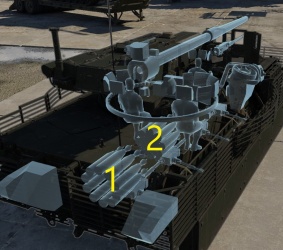
| Full ammo |
1st rack empty |
2nd rack empty |
Visual discrepancy |
|---|---|---|---|
| 18 | 9 (+9) | 1 (+17) | No |
Notes:
- Shells are modeled individually and disappear after having been shot or loaded.
- Rack 2 (autoloader magazine) is a first stage ammo rack and totals 8 shells.
- As the M1128 is equipped with an autoloader, manual reloading of the gun is not possible.
- Once the autoloader magazine has been depleted, you can't shoot until the loader has restocked the autoloader with at least one shell.
- The restocking time is longer than the normal reload time of the gun. Take this into account when playing.
- Simply not firing when the gun is loaded will move ammo from rack 1 into rack 2. Firing will interrupt the restocking of the ready racks.
Machine guns
| 12.7 mm M2HB | ||||
|---|---|---|---|---|
| Mount | Capacity (Belt) | Fire rate | Vertical | Horizontal |
| Pintle | 400 (200) | 577 | -5°/+30° | -5°/+70° |
| 7.62 mm M240 | ||||
|---|---|---|---|---|
| Mount | Capacity (Belt) | Fire rate | Vertical | Horizontal |
| Coaxial | 3,400 (200) | 941 | N/A | N/A |
Usage in battles
The M1128 is best played as an ambush-sniper. Take full advantage of the vehicle's mobility to get to sniping positions first and avoid open areas when you can. With the M1128's unmanned turret, it is best used at a hull-down position. The M1128 is also vulnerable to the overpressure mechanic and has inconsistent and poor armour which means that you should approach all enemies with caution. When the opportunity presents itself, it is always best to double back or reposition and fight your enemy in a position fight.
Urban combat
The M1128 performs rather poorly in urban combat since it is a large vehicle. Although it has an excellent turret traverse speed, close-quarters fighting is not advised as the tank is vulnerable to all kinds of fire. The M1128's reload rate is decent for its BR and is able to quickly dispatch multiple enemies. Therefore, you should avoid close-quarters engagements and try to reposition when possible.
Rural Combat
The M1128 excels in large, open maps. Taking full advantage of its mobility and firepower, it is best to reach advantageous positions early in the game. Using the high-resolution thermal sights, it is easy to spot enemies and quickly neutralize them.
Pros and cons
Pros:
- High resolution thermal gunner and commander optics (3rd generation), as well as low resolution driver thermal optics (1st generation).
- Has access to the M900 high penetration APFSDS round when spaded.
- Autoloader allows a 7.5 second reload no matter the amount of crew members left or their health.
- Can put another shell in the autoloader in only 6 seconds; it is not affected by crew skill.
- High turret traverse speed (40°/sec with an ace crew) allows great reactionary ability.
- Unmanned turret can protect the crew from harm thanks to their location in the hull.
- Can fire smoke grenades three times, four grenades each time (total of 12 smoke grenades).
- .50 calibre machine gun can be used against low-flying aerial targets and lightly armoured ground vehicles.
- Acceleration is good especially without the add-on slat armour
Cons:
- 7.5 second reload is longer than for many vehicles with a 105 mm gun and an expert or ace crew.
- .50 calibre machine gun does not have full 360 degrees of traverse unlike most other pintle-mounted guns
- Can only carry 18 rounds of ammunition, which may not always be enough.
- Thin armour can only protect against machine gun rounds; it is not able to protect against autocannons.
- It has a very large profile, making it an easy target.
- Suffers mildly from overpressure mechanic.
- Can not neutral steer and the off-road mobility is poor because of the wheeled design.
- Add-on slat armour around the vehicle is quite inconsistent with stopping HEAT/HEAT-FS shells.
- Slat armour also adds 5 tons of weight, reducing the power-to-weight ratio to 14.96 hp/ton; severely impacts acceleration
- Poor gun depression angles
History
Development
The XM1128 MGS was designed by General Dynamics Land Systems (GDLS) - Canada to meet the US Army's Mobile Gun System (MGS) requirement, a requirement for an airmobile infantry support platform that could double in the anti-tank role. The first XM1128 prototype was completed in 1999, and after being chosen as the winner of the competition, eight pre-production units began delivery in 2002 after being redesignated as the M1128 Stryker MGS. The M1128 Stryker entered service with the US Army in 2007.
The M1128 Stryker uses the chassis of the GDLS-Canada Stryker - which is based on the LAV-III. The General Dynamics Low-Profile Turret (LPT) is used, which is a modified version of the turret from the Expeditionary Tank. It is designed to be light enough to easily be transported by air. In 2005, after issues with the autoloading mechanism, the autoloader was changed.
Design
The driver sits in the front left part of the hull, next to the engine on the right side. The driver can access his position through a hinged, one piece folding hatch or through the crew compartment. Three M17 day periscopes are located in the driver's hatch; the first one can be replaced by an image intensifier for night operations. A thermal viewer can be fitted in front of the driver as well.
The LPT is located towards the rear of the hull, with the commander sitting on the right and the gunner on the left, rounding off the crew of three. The LPT is significantly lighter than a conventional turret, whilst also presenting a smaller target to the enemy.
The main armament is a 105 mm M68A1E8 gun. It has 360° of traverse and elevation angles of -5° to +15°. The turret uses electrical controls, but manual controls are available for emergency situations. Both the gunner and commander can control the turret and fire the main gun. The main gun has a fire rate of 10 rounds per minute.
The main gun is fed by an automatic loading system, replacing a human loader. The automatic loading system contains eight rounds, and ten more rounds are carried in the hull for a total of 18 rounds of 105 mm ammunition. The autoloading mechanism can be refilled automatically with only six seconds per shell.
The M1128 is capable of firing M900 APFSDS anti-tank rounds, M456A2 HEAT anti-tank and anti-infantry rounds, M394A3 HEP (also known as HESH) rounds for bunker-busting, and M1040 canister rounds for anti-infantry duty.
The gunner has a single piece hatch with three M27 day periscopes. He also has access to a roof-mounted day/thermal sighting system with a laser rangefinder. The commander's one piece hatch has six M27 day periscopes and on production vehicles also has a panoramic viewer with day and thermal capability. As a backup to the main winner's sight, a x7 magnification day sight is provided for both the gunner and commander.
A 7.62 mm machine gun is located coaxially to the left of the main gun. Additionally, a 12.7 mm machine gun is available for use by the commander. On pre-production units the .50 cal machine gun was pintle-mounted, but it was mounted on a skate rail on production vehicles. Smoke grenade launchers are mounted on each side of the turret, with the amount and location depending on the model (prototype, pre-production, or production). The production version has two banks of four smoke grenades on the left (gunner's) side and one bank of four on the right (commander's) side, for a total of 12 smoke grenades.
The main gun and coaxial machine gun are fully stabilized, as are the gunner and commander's sights. The General Dynamics fire-control computer is used as the fire-control system (FCS).
The M1128 utilizes welded steel armour, with a layer of ceramic applique armour bolted to the exterior as standard. A small liner is fitted to specific areas of the interior to minimize the damage of a penetration.
An armour package consisting of slat, also known as bar, armour can be fitted. This prematurely detonated rocket propelled grenades, preventing penetration. To further enhance protection, composite screens can be added to protect the wheels.
The powerpack is located in the front of the hull, to the right of the driver. It consists of a Caterpillar 3126A diesel engine - producing 350 horsepower - and an Allison MD 3560 P automatic transmission. The transmission has six forward gears and one reverse gear. The maximum attainable speed is 100 km/h, and it has a range of 530 km.
The M1128 has eight wheels and uses power-assisted steering, with the front two axles being engaged in steering. A central tire pressure regulation system is fitted to allow the adjustment of tire pressure as needed.
The M1128 Stryker MGS is fitted with a heating and air conditioning system, vehicle and external communications system, an automatic fire detection and suppression system, and a GPS. A nuclear, biological, chemical (NBC) protection system is fitted for the crew compartment.
An auxiliary power unit (APU) can be fitted, as can a hydraulic winch for self-recovery or for moving of other vehicles or obstacles.
Production and Service
The XM1128 prototype was first built in 1999, and eight pre-production vehicles were built by 2002. The Army originally planned to purchase 204 M1128 Strykers, but only ended up buying 142 in total, due to issues with the turret and autoloader.
In 2013, there were 27 M1128 Strykers assigned to each Stryker Brigade, but the number was then reduced to ten. The M1128 Stryker MGS is - and was always intended to be - used to support the infantry. Despite having anti-tank capability, anti-tank operations are a secondary role for the Stryker MGS, with infantry support being the primary role.
A platoon of three Stryker MGS is attached to each Stryker infantry company, one MGS supporting each Stryker infantry platoon.
Three M1128 Strykers have been lost to combat in the Middle East.
In 2022, the US Army announced the retirement of the original model of the M1128 Stryker MGS, citing obsolescence of its cannon and autoloader, as well as lack of protection against IEDs and anti-tank mines. Updated and improved variants of the Stryker continue to be operated in its absence.
Devblog
Following the end of the Cold War, leading U.S. Army theorists believed that the armoured branch of the armed forces was no longer suitably equipped to perform future operations, projected to be "low-intensity" operations. As a result, the need for a new vehicle, which would bridge the gap between heavily and lightly armoured units, became increasingly apparent.
To address this, the Army issued a set of requirements for the new vehicle and invited close to a dozen manufacturers to design demonstrator vehicles to be tested in late 1999. Among them, General Dynamics Land Systems' LAV III-105 was eventually proclaimed the winner of the competition in November 2000. Shortly after, the LAV III-105 received the name 'Stryker' and plans were made to manufacture over 2,100 units.
In 2002, the XM-M1128 MGS was built, however technical difficulties and deficiencies in the design caused delays to the start of its production. By 2005, low rate production of the vehicle was approved, while new shortcomings in the design were found. Eventually, the vehicle received a significant redesign of certain elements in 2008, being later approved for full production in 2014.
During its early production phase, several Stryker MGS vehicles were sent overseas for combat trials in the Middle East of which 3 would be lost. At present, over 140 M1128 Stryker MGS' have been built and actively serve with the U.S. Army.
Media
- Skins
- Images
- M1128 Stryker MGS Devblog Images
- Videos
See also
- Other MCV/MGS's
External links
| General Dynamics Land Systems (GDLS) | |
|---|---|
| MBTs | IPM1 Abrams · M1A1 · M1A1 HC · M1A2 Abrams · M1A2 SEP |
| Tank destroyers | M1128 Stryker MGS |
| USA light tanks | |
|---|---|
| LVT | LVT(A)(1) · ○LVT(A)(1) · LVT(A)(4) |
| M2 | M2A2 · M2A4 · M2A4 (1st Arm.Div.) |
| M3/M5 Stuart | M3 Stuart · M3A1 Stuart · M3A1 (USMC) · M5A1 · M5A1 TD · ▃Stuart VI (5th CAD) |
| M22 Locust | M22 |
| M24 Chaffee | M24 · M24 (TL) |
| M18 Hellcat | M18 GMC · M18 "Black Cat" · Super Hellcat |
| M41 Walker Bulldog | M41A1 |
| M551 Sheridan | M551 · M551(76) |
| M3 Bradley | M3 Bradley · M3A3 Bradley |
| Wheeled | M8 LAC · T18E2 · M1128 · M1128 Wolfpack |
| Other | M8A1 GMC · T92 · T114 · HSTV-L · CCVL · XM8 · XM800T · AGS |
- Ground vehicles
- USA ground vehicles
- Seventh rank ground vehicles
- Light tanks
- Ground vehicles with smoke grenades
- Ground vehicles with hydropneumatic suspension
- Ground vehicles with night vision device
- Ground vehicles with thermal sight
- Ground vehicles with autoloader
- Ground vehicles with gun stabilizer
- Wheeled ground vehicles


